Entrepreneurship and Small Business Management
VerifiedAdded on 2023/01/13
|17
|5516
|50
AI Summary
This document provides an overview of entrepreneurship and small business management. It covers different types of entrepreneurial ventures, their relation to entrepreneurship topologies, similarities and differences between entrepreneurial ventures, and the growth of entrepreneurial ventures. It also discusses the impact of micro and small businesses on the economy, the importance of small businesses and start-ups to the growth of the social economy, and the characteristics of successful entrepreneurs. Additionally, it examines how background and experience can hinder or foster entrepreneurship.
Contribute Materials
Your contribution can guide someone’s learning journey. Share your
documents today.

ENTREPRENEURSHIP
AND SMALL BUSINESS
MANAGEMENT
AND SMALL BUSINESS
MANAGEMENT
Secure Best Marks with AI Grader
Need help grading? Try our AI Grader for instant feedback on your assignments.
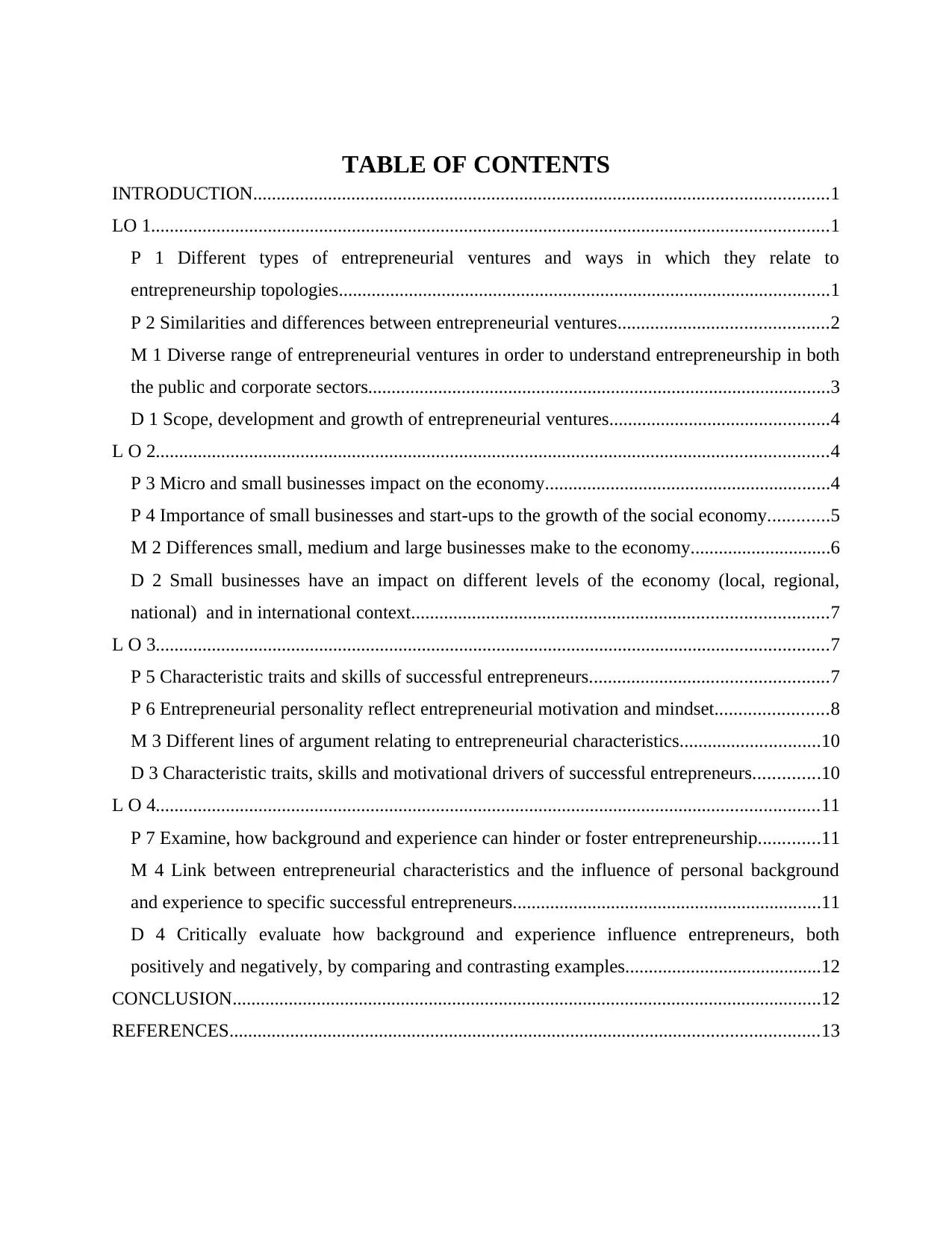
TABLE OF CONTENTS
INTRODUCTION...........................................................................................................................1
LO 1.................................................................................................................................................1
P 1 Different types of entrepreneurial ventures and ways in which they relate to
entrepreneurship topologies.........................................................................................................1
P 2 Similarities and differences between entrepreneurial ventures.............................................2
M 1 Diverse range of entrepreneurial ventures in order to understand entrepreneurship in both
the public and corporate sectors...................................................................................................3
D 1 Scope, development and growth of entrepreneurial ventures...............................................4
L O 2................................................................................................................................................4
P 3 Micro and small businesses impact on the economy.............................................................4
P 4 Importance of small businesses and start-ups to the growth of the social economy.............5
M 2 Differences small, medium and large businesses make to the economy..............................6
D 2 Small businesses have an impact on different levels of the economy (local, regional,
national) and in international context.........................................................................................7
L O 3................................................................................................................................................7
P 5 Characteristic traits and skills of successful entrepreneurs...................................................7
P 6 Entrepreneurial personality reflect entrepreneurial motivation and mindset........................8
M 3 Different lines of argument relating to entrepreneurial characteristics..............................10
D 3 Characteristic traits, skills and motivational drivers of successful entrepreneurs..............10
L O 4..............................................................................................................................................11
P 7 Examine, how background and experience can hinder or foster entrepreneurship.............11
M 4 Link between entrepreneurial characteristics and the influence of personal background
and experience to specific successful entrepreneurs..................................................................11
D 4 Critically evaluate how background and experience influence entrepreneurs, both
positively and negatively, by comparing and contrasting examples..........................................12
CONCLUSION..............................................................................................................................12
REFERENCES..............................................................................................................................13
INTRODUCTION...........................................................................................................................1
LO 1.................................................................................................................................................1
P 1 Different types of entrepreneurial ventures and ways in which they relate to
entrepreneurship topologies.........................................................................................................1
P 2 Similarities and differences between entrepreneurial ventures.............................................2
M 1 Diverse range of entrepreneurial ventures in order to understand entrepreneurship in both
the public and corporate sectors...................................................................................................3
D 1 Scope, development and growth of entrepreneurial ventures...............................................4
L O 2................................................................................................................................................4
P 3 Micro and small businesses impact on the economy.............................................................4
P 4 Importance of small businesses and start-ups to the growth of the social economy.............5
M 2 Differences small, medium and large businesses make to the economy..............................6
D 2 Small businesses have an impact on different levels of the economy (local, regional,
national) and in international context.........................................................................................7
L O 3................................................................................................................................................7
P 5 Characteristic traits and skills of successful entrepreneurs...................................................7
P 6 Entrepreneurial personality reflect entrepreneurial motivation and mindset........................8
M 3 Different lines of argument relating to entrepreneurial characteristics..............................10
D 3 Characteristic traits, skills and motivational drivers of successful entrepreneurs..............10
L O 4..............................................................................................................................................11
P 7 Examine, how background and experience can hinder or foster entrepreneurship.............11
M 4 Link between entrepreneurial characteristics and the influence of personal background
and experience to specific successful entrepreneurs..................................................................11
D 4 Critically evaluate how background and experience influence entrepreneurs, both
positively and negatively, by comparing and contrasting examples..........................................12
CONCLUSION..............................................................................................................................12
REFERENCES..............................................................................................................................13
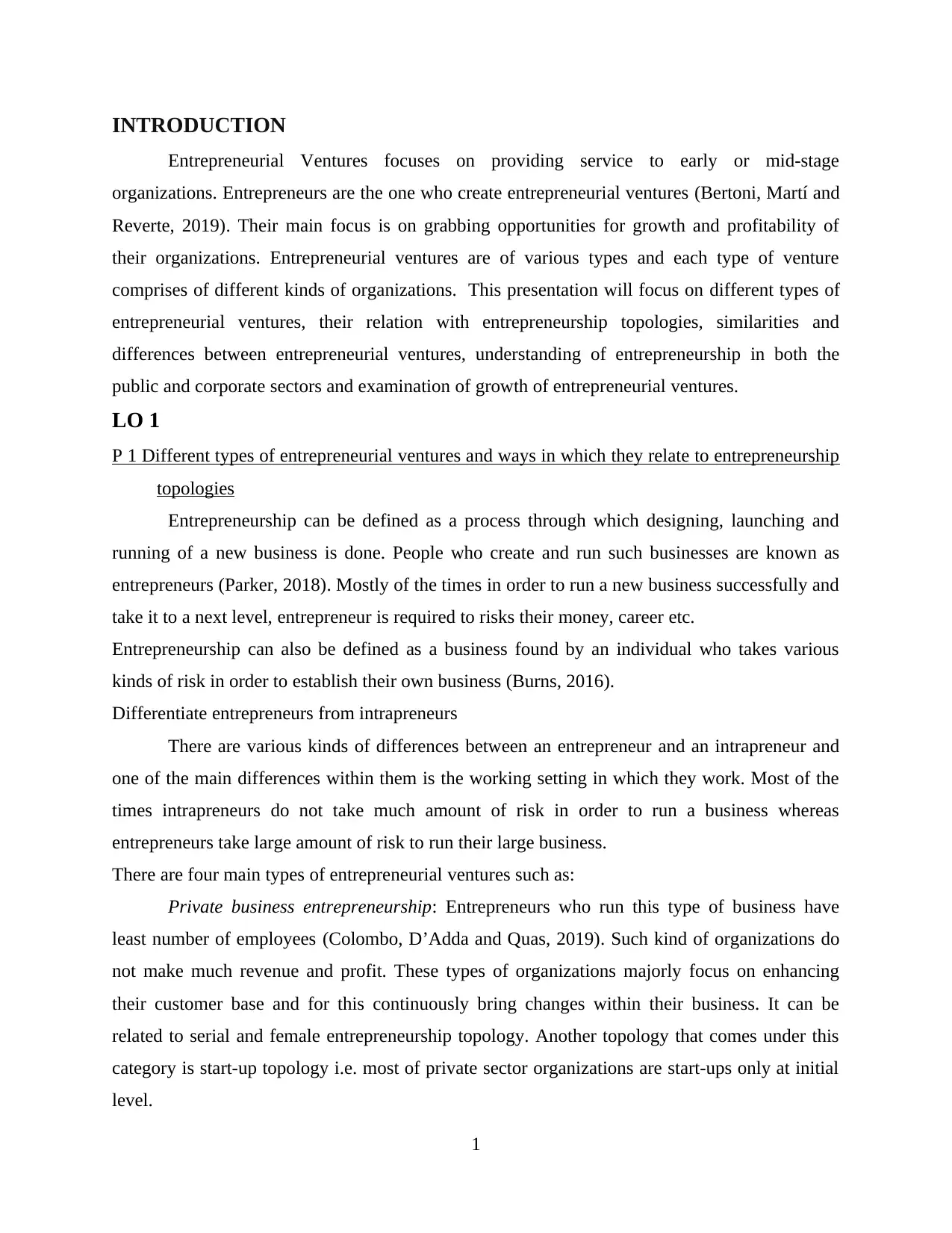
INTRODUCTION
Entrepreneurial Ventures focuses on providing service to early or mid-stage
organizations. Entrepreneurs are the one who create entrepreneurial ventures (Bertoni, Martí and
Reverte, 2019). Their main focus is on grabbing opportunities for growth and profitability of
their organizations. Entrepreneurial ventures are of various types and each type of venture
comprises of different kinds of organizations. This presentation will focus on different types of
entrepreneurial ventures, their relation with entrepreneurship topologies, similarities and
differences between entrepreneurial ventures, understanding of entrepreneurship in both the
public and corporate sectors and examination of growth of entrepreneurial ventures.
LO 1
P 1 Different types of entrepreneurial ventures and ways in which they relate to entrepreneurship
topologies
Entrepreneurship can be defined as a process through which designing, launching and
running of a new business is done. People who create and run such businesses are known as
entrepreneurs (Parker, 2018). Mostly of the times in order to run a new business successfully and
take it to a next level, entrepreneur is required to risks their money, career etc.
Entrepreneurship can also be defined as a business found by an individual who takes various
kinds of risk in order to establish their own business (Burns, 2016).
Differentiate entrepreneurs from intrapreneurs
There are various kinds of differences between an entrepreneur and an intrapreneur and
one of the main differences within them is the working setting in which they work. Most of the
times intrapreneurs do not take much amount of risk in order to run a business whereas
entrepreneurs take large amount of risk to run their large business.
There are four main types of entrepreneurial ventures such as:
Private business entrepreneurship: Entrepreneurs who run this type of business have
least number of employees (Colombo, D’Adda and Quas, 2019). Such kind of organizations do
not make much revenue and profit. These types of organizations majorly focus on enhancing
their customer base and for this continuously bring changes within their business. It can be
related to serial and female entrepreneurship topology. Another topology that comes under this
category is start-up topology i.e. most of private sector organizations are start-ups only at initial
level.
1
Entrepreneurial Ventures focuses on providing service to early or mid-stage
organizations. Entrepreneurs are the one who create entrepreneurial ventures (Bertoni, Martí and
Reverte, 2019). Their main focus is on grabbing opportunities for growth and profitability of
their organizations. Entrepreneurial ventures are of various types and each type of venture
comprises of different kinds of organizations. This presentation will focus on different types of
entrepreneurial ventures, their relation with entrepreneurship topologies, similarities and
differences between entrepreneurial ventures, understanding of entrepreneurship in both the
public and corporate sectors and examination of growth of entrepreneurial ventures.
LO 1
P 1 Different types of entrepreneurial ventures and ways in which they relate to entrepreneurship
topologies
Entrepreneurship can be defined as a process through which designing, launching and
running of a new business is done. People who create and run such businesses are known as
entrepreneurs (Parker, 2018). Mostly of the times in order to run a new business successfully and
take it to a next level, entrepreneur is required to risks their money, career etc.
Entrepreneurship can also be defined as a business found by an individual who takes various
kinds of risk in order to establish their own business (Burns, 2016).
Differentiate entrepreneurs from intrapreneurs
There are various kinds of differences between an entrepreneur and an intrapreneur and
one of the main differences within them is the working setting in which they work. Most of the
times intrapreneurs do not take much amount of risk in order to run a business whereas
entrepreneurs take large amount of risk to run their large business.
There are four main types of entrepreneurial ventures such as:
Private business entrepreneurship: Entrepreneurs who run this type of business have
least number of employees (Colombo, D’Adda and Quas, 2019). Such kind of organizations do
not make much revenue and profit. These types of organizations majorly focus on enhancing
their customer base and for this continuously bring changes within their business. It can be
related to serial and female entrepreneurship topology. Another topology that comes under this
category is start-up topology i.e. most of private sector organizations are start-ups only at initial
level.
1
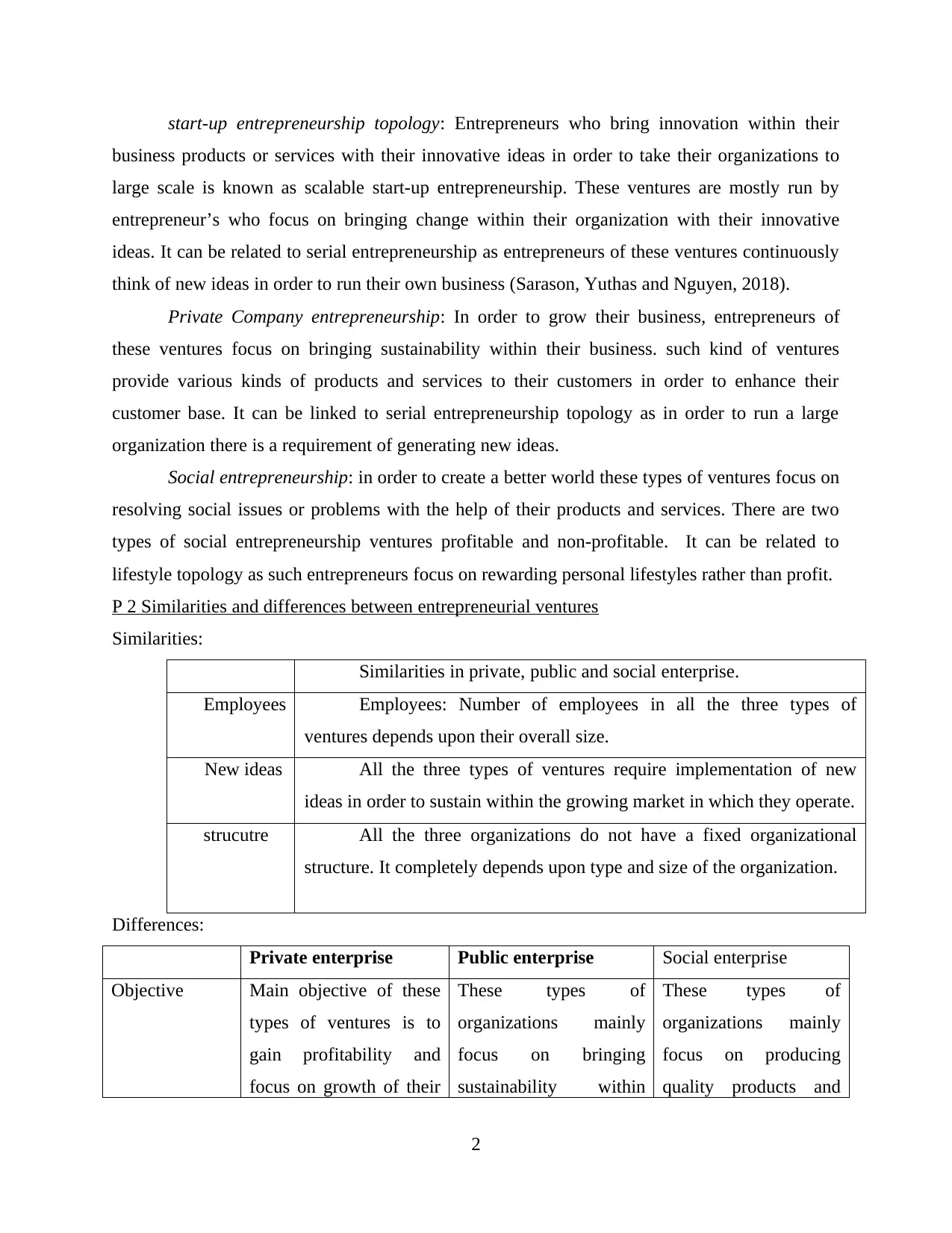
start-up entrepreneurship topology: Entrepreneurs who bring innovation within their
business products or services with their innovative ideas in order to take their organizations to
large scale is known as scalable start-up entrepreneurship. These ventures are mostly run by
entrepreneur’s who focus on bringing change within their organization with their innovative
ideas. It can be related to serial entrepreneurship as entrepreneurs of these ventures continuously
think of new ideas in order to run their own business (Sarason, Yuthas and Nguyen, 2018).
Private Company entrepreneurship: In order to grow their business, entrepreneurs of
these ventures focus on bringing sustainability within their business. such kind of ventures
provide various kinds of products and services to their customers in order to enhance their
customer base. It can be linked to serial entrepreneurship topology as in order to run a large
organization there is a requirement of generating new ideas.
Social entrepreneurship: in order to create a better world these types of ventures focus on
resolving social issues or problems with the help of their products and services. There are two
types of social entrepreneurship ventures profitable and non-profitable. It can be related to
lifestyle topology as such entrepreneurs focus on rewarding personal lifestyles rather than profit.
P 2 Similarities and differences between entrepreneurial ventures
Similarities:
Similarities in private, public and social enterprise.
Employees Employees: Number of employees in all the three types of
ventures depends upon their overall size.
New ideas All the three types of ventures require implementation of new
ideas in order to sustain within the growing market in which they operate.
strucutre All the three organizations do not have a fixed organizational
structure. It completely depends upon type and size of the organization.
Differences:
Private enterprise Public enterprise Social enterprise
Objective Main objective of these
types of ventures is to
gain profitability and
focus on growth of their
These types of
organizations mainly
focus on bringing
sustainability within
These types of
organizations mainly
focus on producing
quality products and
2
business products or services with their innovative ideas in order to take their organizations to
large scale is known as scalable start-up entrepreneurship. These ventures are mostly run by
entrepreneur’s who focus on bringing change within their organization with their innovative
ideas. It can be related to serial entrepreneurship as entrepreneurs of these ventures continuously
think of new ideas in order to run their own business (Sarason, Yuthas and Nguyen, 2018).
Private Company entrepreneurship: In order to grow their business, entrepreneurs of
these ventures focus on bringing sustainability within their business. such kind of ventures
provide various kinds of products and services to their customers in order to enhance their
customer base. It can be linked to serial entrepreneurship topology as in order to run a large
organization there is a requirement of generating new ideas.
Social entrepreneurship: in order to create a better world these types of ventures focus on
resolving social issues or problems with the help of their products and services. There are two
types of social entrepreneurship ventures profitable and non-profitable. It can be related to
lifestyle topology as such entrepreneurs focus on rewarding personal lifestyles rather than profit.
P 2 Similarities and differences between entrepreneurial ventures
Similarities:
Similarities in private, public and social enterprise.
Employees Employees: Number of employees in all the three types of
ventures depends upon their overall size.
New ideas All the three types of ventures require implementation of new
ideas in order to sustain within the growing market in which they operate.
strucutre All the three organizations do not have a fixed organizational
structure. It completely depends upon type and size of the organization.
Differences:
Private enterprise Public enterprise Social enterprise
Objective Main objective of these
types of ventures is to
gain profitability and
focus on growth of their
These types of
organizations mainly
focus on bringing
sustainability within
These types of
organizations mainly
focus on producing
quality products and
2
Secure Best Marks with AI Grader
Need help grading? Try our AI Grader for instant feedback on your assignments.
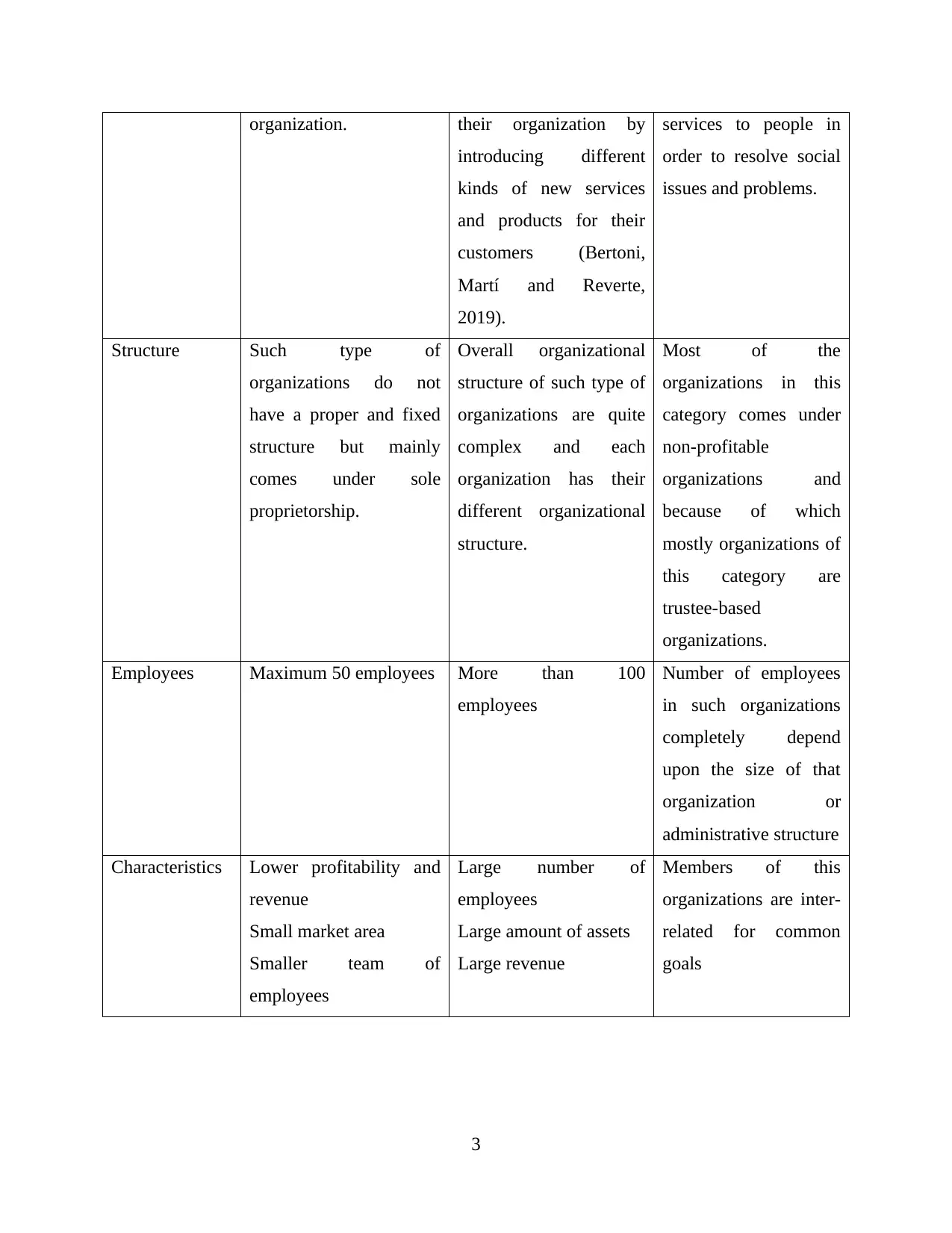
organization. their organization by
introducing different
kinds of new services
and products for their
customers (Bertoni,
Martí and Reverte,
2019).
services to people in
order to resolve social
issues and problems.
Structure Such type of
organizations do not
have a proper and fixed
structure but mainly
comes under sole
proprietorship.
Overall organizational
structure of such type of
organizations are quite
complex and each
organization has their
different organizational
structure.
Most of the
organizations in this
category comes under
non-profitable
organizations and
because of which
mostly organizations of
this category are
trustee-based
organizations.
Employees Maximum 50 employees More than 100
employees
Number of employees
in such organizations
completely depend
upon the size of that
organization or
administrative structure
Characteristics Lower profitability and
revenue
Small market area
Smaller team of
employees
Large number of
employees
Large amount of assets
Large revenue
Members of this
organizations are inter-
related for common
goals
3
introducing different
kinds of new services
and products for their
customers (Bertoni,
Martí and Reverte,
2019).
services to people in
order to resolve social
issues and problems.
Structure Such type of
organizations do not
have a proper and fixed
structure but mainly
comes under sole
proprietorship.
Overall organizational
structure of such type of
organizations are quite
complex and each
organization has their
different organizational
structure.
Most of the
organizations in this
category comes under
non-profitable
organizations and
because of which
mostly organizations of
this category are
trustee-based
organizations.
Employees Maximum 50 employees More than 100
employees
Number of employees
in such organizations
completely depend
upon the size of that
organization or
administrative structure
Characteristics Lower profitability and
revenue
Small market area
Smaller team of
employees
Large number of
employees
Large amount of assets
Large revenue
Members of this
organizations are inter-
related for common
goals
3
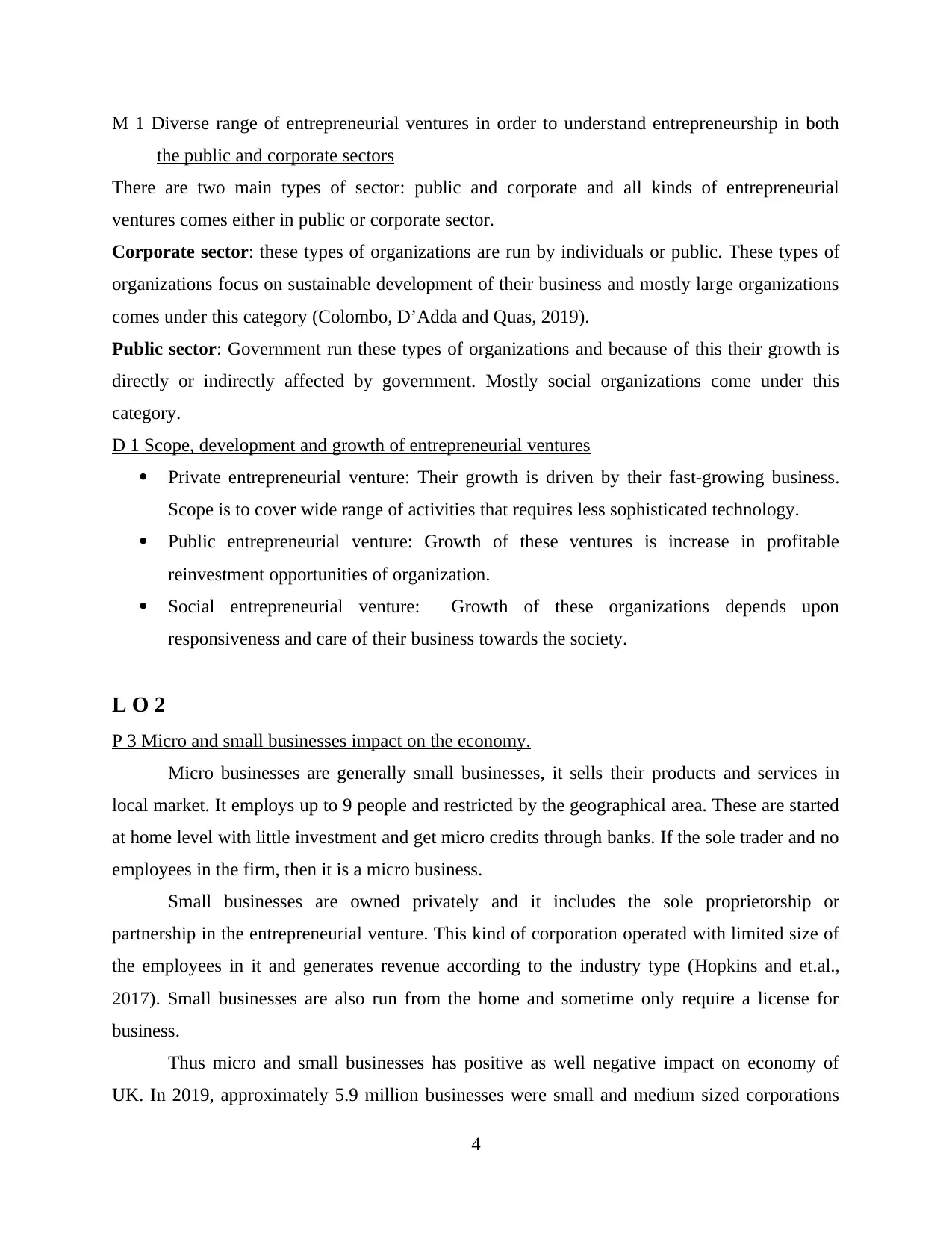
M 1 Diverse range of entrepreneurial ventures in order to understand entrepreneurship in both
the public and corporate sectors
There are two main types of sector: public and corporate and all kinds of entrepreneurial
ventures comes either in public or corporate sector.
Corporate sector: these types of organizations are run by individuals or public. These types of
organizations focus on sustainable development of their business and mostly large organizations
comes under this category (Colombo, D’Adda and Quas, 2019).
Public sector: Government run these types of organizations and because of this their growth is
directly or indirectly affected by government. Mostly social organizations come under this
category.
D 1 Scope, development and growth of entrepreneurial ventures
Private entrepreneurial venture: Their growth is driven by their fast-growing business.
Scope is to cover wide range of activities that requires less sophisticated technology.
Public entrepreneurial venture: Growth of these ventures is increase in profitable
reinvestment opportunities of organization.
Social entrepreneurial venture: Growth of these organizations depends upon
responsiveness and care of their business towards the society.
L O 2
P 3 Micro and small businesses impact on the economy.
Micro businesses are generally small businesses, it sells their products and services in
local market. It employs up to 9 people and restricted by the geographical area. These are started
at home level with little investment and get micro credits through banks. If the sole trader and no
employees in the firm, then it is a micro business.
Small businesses are owned privately and it includes the sole proprietorship or
partnership in the entrepreneurial venture. This kind of corporation operated with limited size of
the employees in it and generates revenue according to the industry type (Hopkins and et.al.,
2017). Small businesses are also run from the home and sometime only require a license for
business.
Thus micro and small businesses has positive as well negative impact on economy of
UK. In 2019, approximately 5.9 million businesses were small and medium sized corporations
4
the public and corporate sectors
There are two main types of sector: public and corporate and all kinds of entrepreneurial
ventures comes either in public or corporate sector.
Corporate sector: these types of organizations are run by individuals or public. These types of
organizations focus on sustainable development of their business and mostly large organizations
comes under this category (Colombo, D’Adda and Quas, 2019).
Public sector: Government run these types of organizations and because of this their growth is
directly or indirectly affected by government. Mostly social organizations come under this
category.
D 1 Scope, development and growth of entrepreneurial ventures
Private entrepreneurial venture: Their growth is driven by their fast-growing business.
Scope is to cover wide range of activities that requires less sophisticated technology.
Public entrepreneurial venture: Growth of these ventures is increase in profitable
reinvestment opportunities of organization.
Social entrepreneurial venture: Growth of these organizations depends upon
responsiveness and care of their business towards the society.
L O 2
P 3 Micro and small businesses impact on the economy.
Micro businesses are generally small businesses, it sells their products and services in
local market. It employs up to 9 people and restricted by the geographical area. These are started
at home level with little investment and get micro credits through banks. If the sole trader and no
employees in the firm, then it is a micro business.
Small businesses are owned privately and it includes the sole proprietorship or
partnership in the entrepreneurial venture. This kind of corporation operated with limited size of
the employees in it and generates revenue according to the industry type (Hopkins and et.al.,
2017). Small businesses are also run from the home and sometime only require a license for
business.
Thus micro and small businesses has positive as well negative impact on economy of
UK. In 2019, approximately 5.9 million businesses were small and medium sized corporations
4
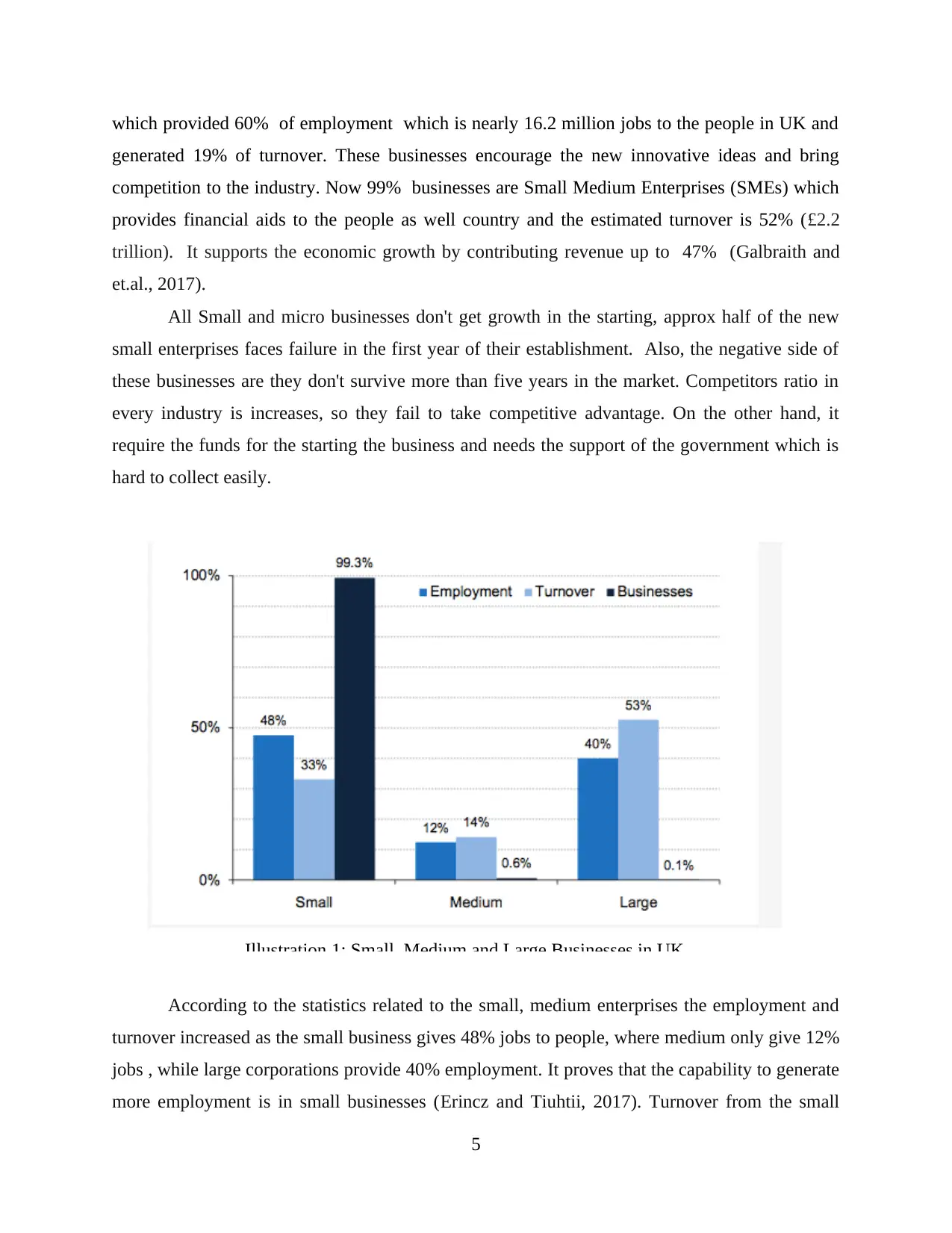
which provided 60% of employment which is nearly 16.2 million jobs to the people in UK and
generated 19% of turnover. These businesses encourage the new innovative ideas and bring
competition to the industry. Now 99% businesses are Small Medium Enterprises (SMEs) which
provides financial aids to the people as well country and the estimated turnover is 52% (£2.2
trillion). It supports the economic growth by contributing revenue up to 47% (Galbraith and
et.al., 2017).
All Small and micro businesses don't get growth in the starting, approx half of the new
small enterprises faces failure in the first year of their establishment. Also, the negative side of
these businesses are they don't survive more than five years in the market. Competitors ratio in
every industry is increases, so they fail to take competitive advantage. On the other hand, it
require the funds for the starting the business and needs the support of the government which is
hard to collect easily.
According to the statistics related to the small, medium enterprises the employment and
turnover increased as the small business gives 48% jobs to people, where medium only give 12%
jobs , while large corporations provide 40% employment. It proves that the capability to generate
more employment is in small businesses (Erincz and Tiuhtii, 2017). Turnover from the small
5
Illustration 1: Small, Medium and Large Businesses in UK
generated 19% of turnover. These businesses encourage the new innovative ideas and bring
competition to the industry. Now 99% businesses are Small Medium Enterprises (SMEs) which
provides financial aids to the people as well country and the estimated turnover is 52% (£2.2
trillion). It supports the economic growth by contributing revenue up to 47% (Galbraith and
et.al., 2017).
All Small and micro businesses don't get growth in the starting, approx half of the new
small enterprises faces failure in the first year of their establishment. Also, the negative side of
these businesses are they don't survive more than five years in the market. Competitors ratio in
every industry is increases, so they fail to take competitive advantage. On the other hand, it
require the funds for the starting the business and needs the support of the government which is
hard to collect easily.
According to the statistics related to the small, medium enterprises the employment and
turnover increased as the small business gives 48% jobs to people, where medium only give 12%
jobs , while large corporations provide 40% employment. It proves that the capability to generate
more employment is in small businesses (Erincz and Tiuhtii, 2017). Turnover from the small
5
Illustration 1: Small, Medium and Large Businesses in UK
Paraphrase This Document
Need a fresh take? Get an instant paraphrase of this document with our AI Paraphraser
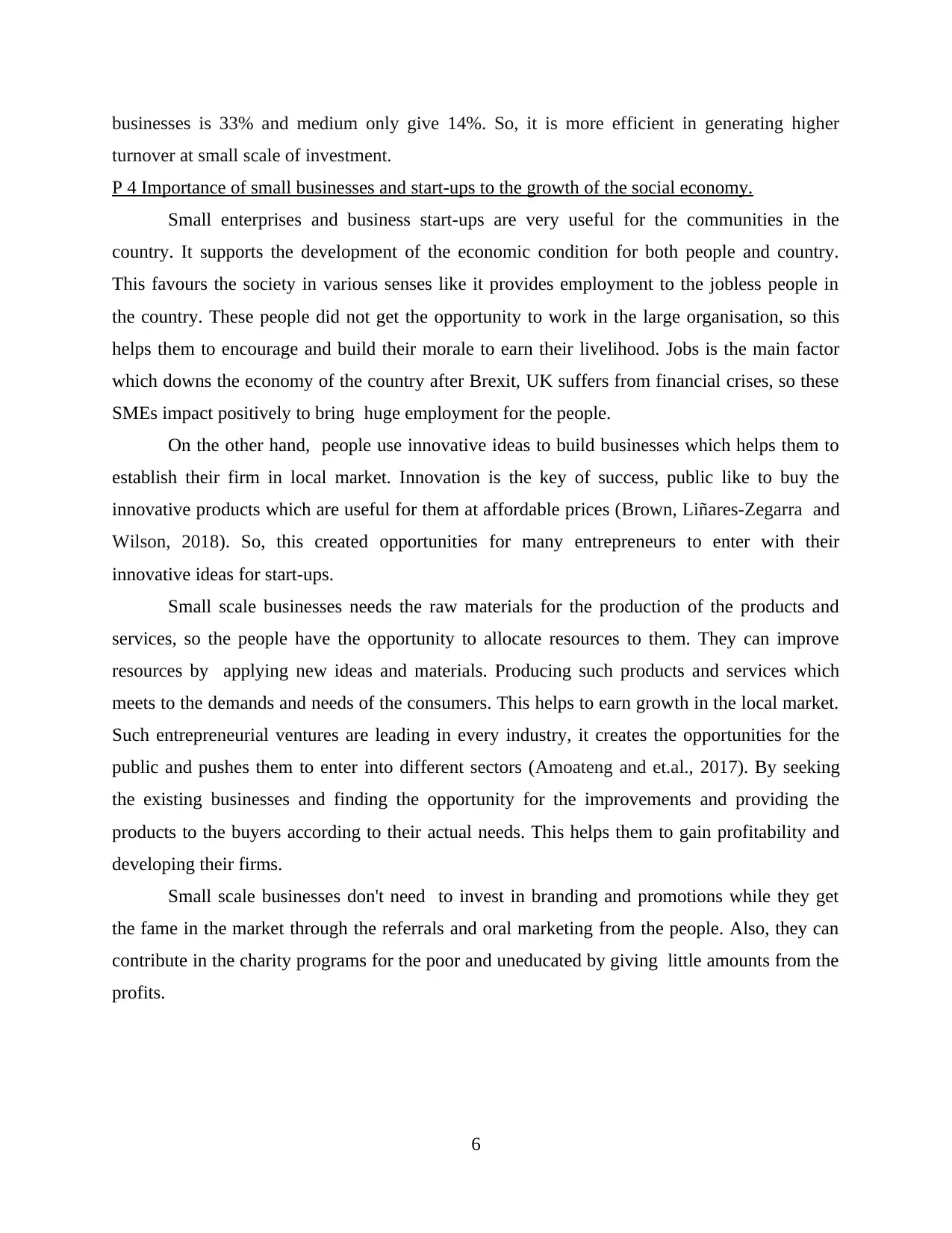
businesses is 33% and medium only give 14%. So, it is more efficient in generating higher
turnover at small scale of investment.
P 4 Importance of small businesses and start-ups to the growth of the social economy.
Small enterprises and business start-ups are very useful for the communities in the
country. It supports the development of the economic condition for both people and country.
This favours the society in various senses like it provides employment to the jobless people in
the country. These people did not get the opportunity to work in the large organisation, so this
helps them to encourage and build their morale to earn their livelihood. Jobs is the main factor
which downs the economy of the country after Brexit, UK suffers from financial crises, so these
SMEs impact positively to bring huge employment for the people.
On the other hand, people use innovative ideas to build businesses which helps them to
establish their firm in local market. Innovation is the key of success, public like to buy the
innovative products which are useful for them at affordable prices (Brown, Liñares-Zegarra and
Wilson, 2018). So, this created opportunities for many entrepreneurs to enter with their
innovative ideas for start-ups.
Small scale businesses needs the raw materials for the production of the products and
services, so the people have the opportunity to allocate resources to them. They can improve
resources by applying new ideas and materials. Producing such products and services which
meets to the demands and needs of the consumers. This helps to earn growth in the local market.
Such entrepreneurial ventures are leading in every industry, it creates the opportunities for the
public and pushes them to enter into different sectors (Amoateng and et.al., 2017). By seeking
the existing businesses and finding the opportunity for the improvements and providing the
products to the buyers according to their actual needs. This helps them to gain profitability and
developing their firms.
Small scale businesses don't need to invest in branding and promotions while they get
the fame in the market through the referrals and oral marketing from the people. Also, they can
contribute in the charity programs for the poor and uneducated by giving little amounts from the
profits.
6
turnover at small scale of investment.
P 4 Importance of small businesses and start-ups to the growth of the social economy.
Small enterprises and business start-ups are very useful for the communities in the
country. It supports the development of the economic condition for both people and country.
This favours the society in various senses like it provides employment to the jobless people in
the country. These people did not get the opportunity to work in the large organisation, so this
helps them to encourage and build their morale to earn their livelihood. Jobs is the main factor
which downs the economy of the country after Brexit, UK suffers from financial crises, so these
SMEs impact positively to bring huge employment for the people.
On the other hand, people use innovative ideas to build businesses which helps them to
establish their firm in local market. Innovation is the key of success, public like to buy the
innovative products which are useful for them at affordable prices (Brown, Liñares-Zegarra and
Wilson, 2018). So, this created opportunities for many entrepreneurs to enter with their
innovative ideas for start-ups.
Small scale businesses needs the raw materials for the production of the products and
services, so the people have the opportunity to allocate resources to them. They can improve
resources by applying new ideas and materials. Producing such products and services which
meets to the demands and needs of the consumers. This helps to earn growth in the local market.
Such entrepreneurial ventures are leading in every industry, it creates the opportunities for the
public and pushes them to enter into different sectors (Amoateng and et.al., 2017). By seeking
the existing businesses and finding the opportunity for the improvements and providing the
products to the buyers according to their actual needs. This helps them to gain profitability and
developing their firms.
Small scale businesses don't need to invest in branding and promotions while they get
the fame in the market through the referrals and oral marketing from the people. Also, they can
contribute in the charity programs for the poor and uneducated by giving little amounts from the
profits.
6
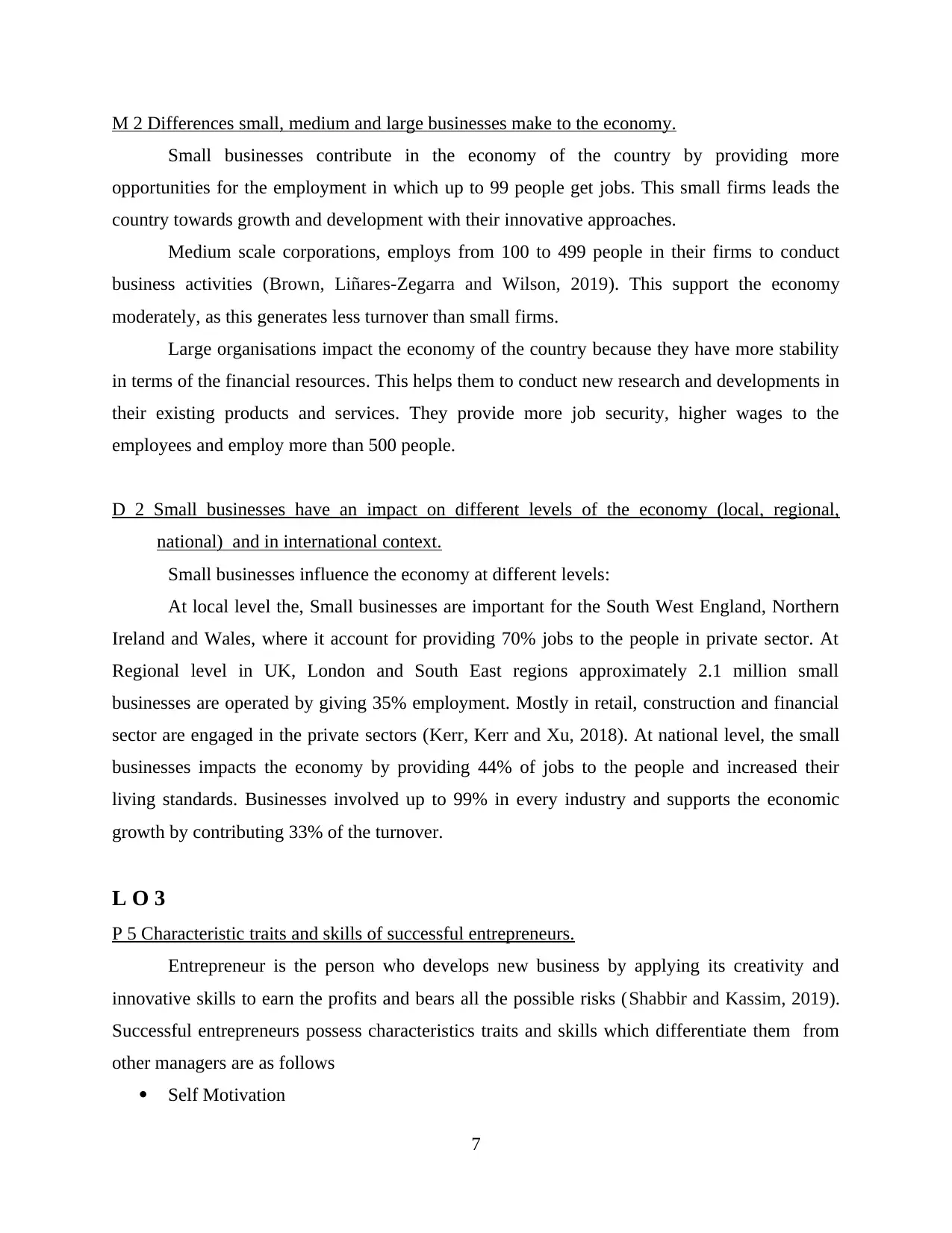
M 2 Differences small, medium and large businesses make to the economy.
Small businesses contribute in the economy of the country by providing more
opportunities for the employment in which up to 99 people get jobs. This small firms leads the
country towards growth and development with their innovative approaches.
Medium scale corporations, employs from 100 to 499 people in their firms to conduct
business activities (Brown, Liñares-Zegarra and Wilson, 2019). This support the economy
moderately, as this generates less turnover than small firms.
Large organisations impact the economy of the country because they have more stability
in terms of the financial resources. This helps them to conduct new research and developments in
their existing products and services. They provide more job security, higher wages to the
employees and employ more than 500 people.
D 2 Small businesses have an impact on different levels of the economy (local, regional,
national) and in international context.
Small businesses influence the economy at different levels:
At local level the, Small businesses are important for the South West England, Northern
Ireland and Wales, where it account for providing 70% jobs to the people in private sector. At
Regional level in UK, London and South East regions approximately 2.1 million small
businesses are operated by giving 35% employment. Mostly in retail, construction and financial
sector are engaged in the private sectors (Kerr, Kerr and Xu, 2018). At national level, the small
businesses impacts the economy by providing 44% of jobs to the people and increased their
living standards. Businesses involved up to 99% in every industry and supports the economic
growth by contributing 33% of the turnover.
L O 3
P 5 Characteristic traits and skills of successful entrepreneurs.
Entrepreneur is the person who develops new business by applying its creativity and
innovative skills to earn the profits and bears all the possible risks (Shabbir and Kassim, 2019).
Successful entrepreneurs possess characteristics traits and skills which differentiate them from
other managers are as follows
Self Motivation
7
Small businesses contribute in the economy of the country by providing more
opportunities for the employment in which up to 99 people get jobs. This small firms leads the
country towards growth and development with their innovative approaches.
Medium scale corporations, employs from 100 to 499 people in their firms to conduct
business activities (Brown, Liñares-Zegarra and Wilson, 2019). This support the economy
moderately, as this generates less turnover than small firms.
Large organisations impact the economy of the country because they have more stability
in terms of the financial resources. This helps them to conduct new research and developments in
their existing products and services. They provide more job security, higher wages to the
employees and employ more than 500 people.
D 2 Small businesses have an impact on different levels of the economy (local, regional,
national) and in international context.
Small businesses influence the economy at different levels:
At local level the, Small businesses are important for the South West England, Northern
Ireland and Wales, where it account for providing 70% jobs to the people in private sector. At
Regional level in UK, London and South East regions approximately 2.1 million small
businesses are operated by giving 35% employment. Mostly in retail, construction and financial
sector are engaged in the private sectors (Kerr, Kerr and Xu, 2018). At national level, the small
businesses impacts the economy by providing 44% of jobs to the people and increased their
living standards. Businesses involved up to 99% in every industry and supports the economic
growth by contributing 33% of the turnover.
L O 3
P 5 Characteristic traits and skills of successful entrepreneurs.
Entrepreneur is the person who develops new business by applying its creativity and
innovative skills to earn the profits and bears all the possible risks (Shabbir and Kassim, 2019).
Successful entrepreneurs possess characteristics traits and skills which differentiate them from
other managers are as follows
Self Motivation
7
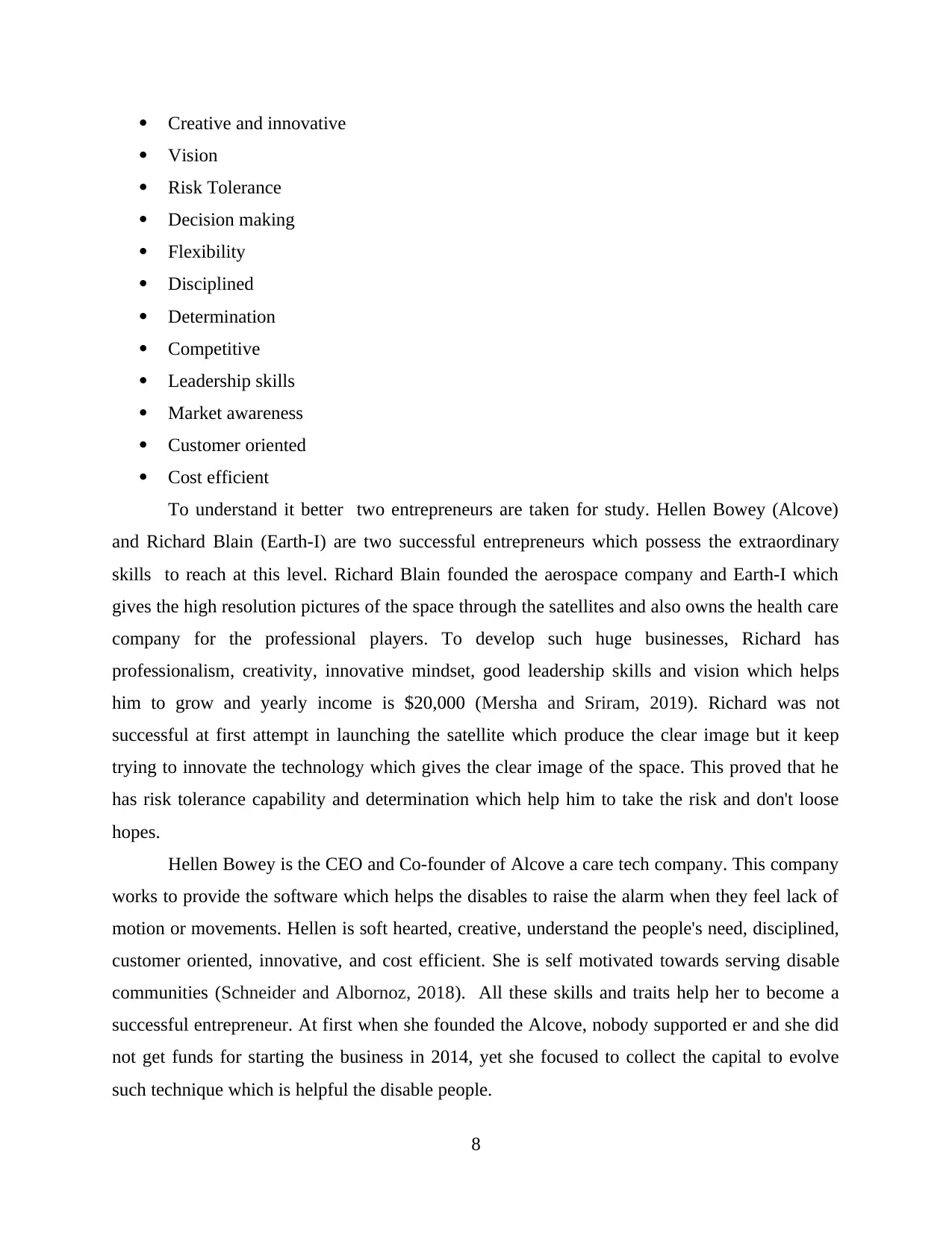
Creative and innovative
Vision
Risk Tolerance
Decision making
Flexibility
Disciplined
Determination
Competitive
Leadership skills
Market awareness
Customer oriented
Cost efficient
To understand it better two entrepreneurs are taken for study. Hellen Bowey (Alcove)
and Richard Blain (Earth-I) are two successful entrepreneurs which possess the extraordinary
skills to reach at this level. Richard Blain founded the aerospace company and Earth-I which
gives the high resolution pictures of the space through the satellites and also owns the health care
company for the professional players. To develop such huge businesses, Richard has
professionalism, creativity, innovative mindset, good leadership skills and vision which helps
him to grow and yearly income is $20,000 (Mersha and Sriram, 2019). Richard was not
successful at first attempt in launching the satellite which produce the clear image but it keep
trying to innovate the technology which gives the clear image of the space. This proved that he
has risk tolerance capability and determination which help him to take the risk and don't loose
hopes.
Hellen Bowey is the CEO and Co-founder of Alcove a care tech company. This company
works to provide the software which helps the disables to raise the alarm when they feel lack of
motion or movements. Hellen is soft hearted, creative, understand the people's need, disciplined,
customer oriented, innovative, and cost efficient. She is self motivated towards serving disable
communities (Schneider and Albornoz, 2018). All these skills and traits help her to become a
successful entrepreneur. At first when she founded the Alcove, nobody supported er and she did
not get funds for starting the business in 2014, yet she focused to collect the capital to evolve
such technique which is helpful the disable people.
8
Vision
Risk Tolerance
Decision making
Flexibility
Disciplined
Determination
Competitive
Leadership skills
Market awareness
Customer oriented
Cost efficient
To understand it better two entrepreneurs are taken for study. Hellen Bowey (Alcove)
and Richard Blain (Earth-I) are two successful entrepreneurs which possess the extraordinary
skills to reach at this level. Richard Blain founded the aerospace company and Earth-I which
gives the high resolution pictures of the space through the satellites and also owns the health care
company for the professional players. To develop such huge businesses, Richard has
professionalism, creativity, innovative mindset, good leadership skills and vision which helps
him to grow and yearly income is $20,000 (Mersha and Sriram, 2019). Richard was not
successful at first attempt in launching the satellite which produce the clear image but it keep
trying to innovate the technology which gives the clear image of the space. This proved that he
has risk tolerance capability and determination which help him to take the risk and don't loose
hopes.
Hellen Bowey is the CEO and Co-founder of Alcove a care tech company. This company
works to provide the software which helps the disables to raise the alarm when they feel lack of
motion or movements. Hellen is soft hearted, creative, understand the people's need, disciplined,
customer oriented, innovative, and cost efficient. She is self motivated towards serving disable
communities (Schneider and Albornoz, 2018). All these skills and traits help her to become a
successful entrepreneur. At first when she founded the Alcove, nobody supported er and she did
not get funds for starting the business in 2014, yet she focused to collect the capital to evolve
such technique which is helpful the disable people.
8
Secure Best Marks with AI Grader
Need help grading? Try our AI Grader for instant feedback on your assignments.
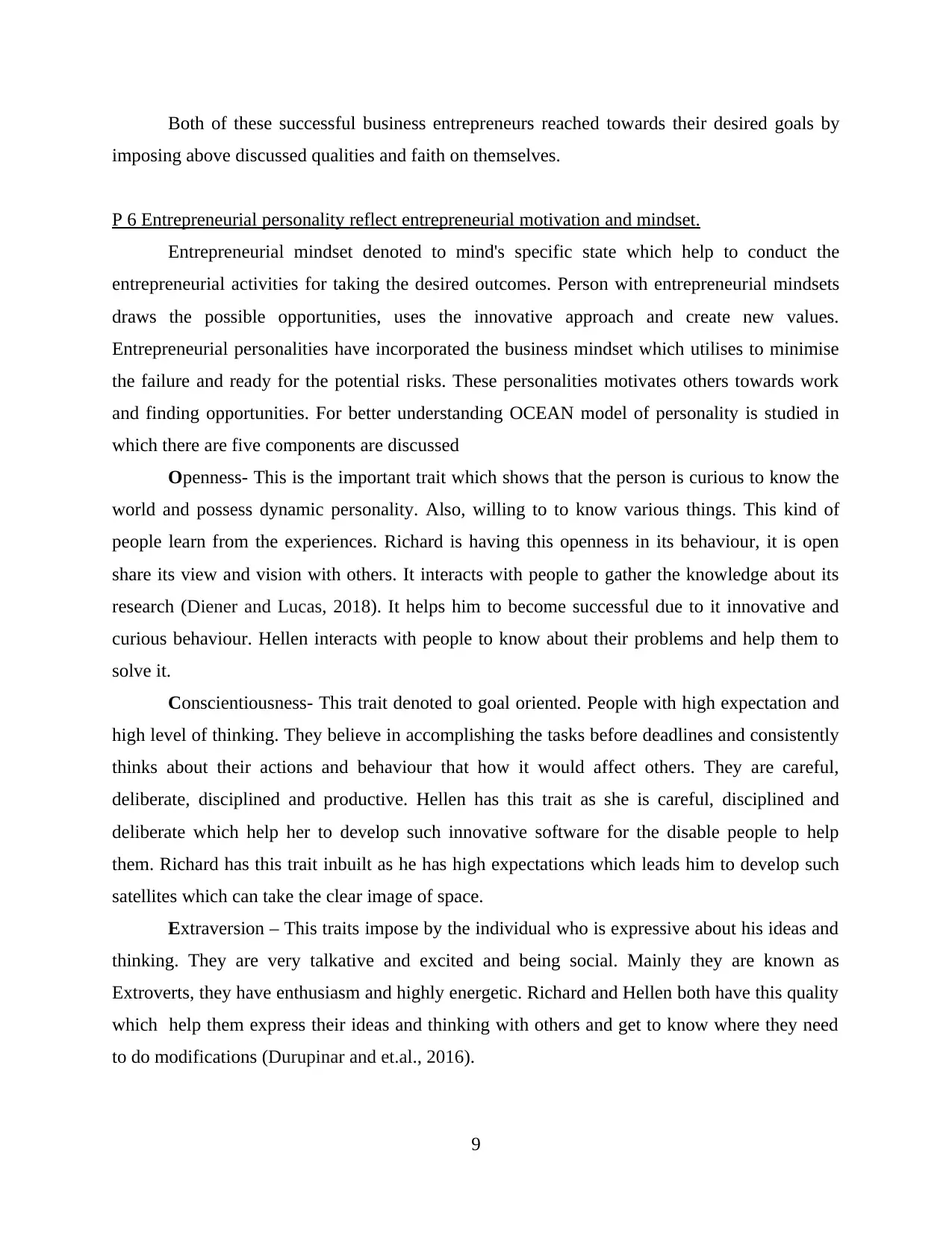
Both of these successful business entrepreneurs reached towards their desired goals by
imposing above discussed qualities and faith on themselves.
P 6 Entrepreneurial personality reflect entrepreneurial motivation and mindset.
Entrepreneurial mindset denoted to mind's specific state which help to conduct the
entrepreneurial activities for taking the desired outcomes. Person with entrepreneurial mindsets
draws the possible opportunities, uses the innovative approach and create new values.
Entrepreneurial personalities have incorporated the business mindset which utilises to minimise
the failure and ready for the potential risks. These personalities motivates others towards work
and finding opportunities. For better understanding OCEAN model of personality is studied in
which there are five components are discussed
Openness- This is the important trait which shows that the person is curious to know the
world and possess dynamic personality. Also, willing to to know various things. This kind of
people learn from the experiences. Richard is having this openness in its behaviour, it is open
share its view and vision with others. It interacts with people to gather the knowledge about its
research (Diener and Lucas, 2018). It helps him to become successful due to it innovative and
curious behaviour. Hellen interacts with people to know about their problems and help them to
solve it.
Conscientiousness- This trait denoted to goal oriented. People with high expectation and
high level of thinking. They believe in accomplishing the tasks before deadlines and consistently
thinks about their actions and behaviour that how it would affect others. They are careful,
deliberate, disciplined and productive. Hellen has this trait as she is careful, disciplined and
deliberate which help her to develop such innovative software for the disable people to help
them. Richard has this trait inbuilt as he has high expectations which leads him to develop such
satellites which can take the clear image of space.
Extraversion – This traits impose by the individual who is expressive about his ideas and
thinking. They are very talkative and excited and being social. Mainly they are known as
Extroverts, they have enthusiasm and highly energetic. Richard and Hellen both have this quality
which help them express their ideas and thinking with others and get to know where they need
to do modifications (Durupinar and et.al., 2016).
9
imposing above discussed qualities and faith on themselves.
P 6 Entrepreneurial personality reflect entrepreneurial motivation and mindset.
Entrepreneurial mindset denoted to mind's specific state which help to conduct the
entrepreneurial activities for taking the desired outcomes. Person with entrepreneurial mindsets
draws the possible opportunities, uses the innovative approach and create new values.
Entrepreneurial personalities have incorporated the business mindset which utilises to minimise
the failure and ready for the potential risks. These personalities motivates others towards work
and finding opportunities. For better understanding OCEAN model of personality is studied in
which there are five components are discussed
Openness- This is the important trait which shows that the person is curious to know the
world and possess dynamic personality. Also, willing to to know various things. This kind of
people learn from the experiences. Richard is having this openness in its behaviour, it is open
share its view and vision with others. It interacts with people to gather the knowledge about its
research (Diener and Lucas, 2018). It helps him to become successful due to it innovative and
curious behaviour. Hellen interacts with people to know about their problems and help them to
solve it.
Conscientiousness- This trait denoted to goal oriented. People with high expectation and
high level of thinking. They believe in accomplishing the tasks before deadlines and consistently
thinks about their actions and behaviour that how it would affect others. They are careful,
deliberate, disciplined and productive. Hellen has this trait as she is careful, disciplined and
deliberate which help her to develop such innovative software for the disable people to help
them. Richard has this trait inbuilt as he has high expectations which leads him to develop such
satellites which can take the clear image of space.
Extraversion – This traits impose by the individual who is expressive about his ideas and
thinking. They are very talkative and excited and being social. Mainly they are known as
Extroverts, they have enthusiasm and highly energetic. Richard and Hellen both have this quality
which help them express their ideas and thinking with others and get to know where they need
to do modifications (Durupinar and et.al., 2016).
9
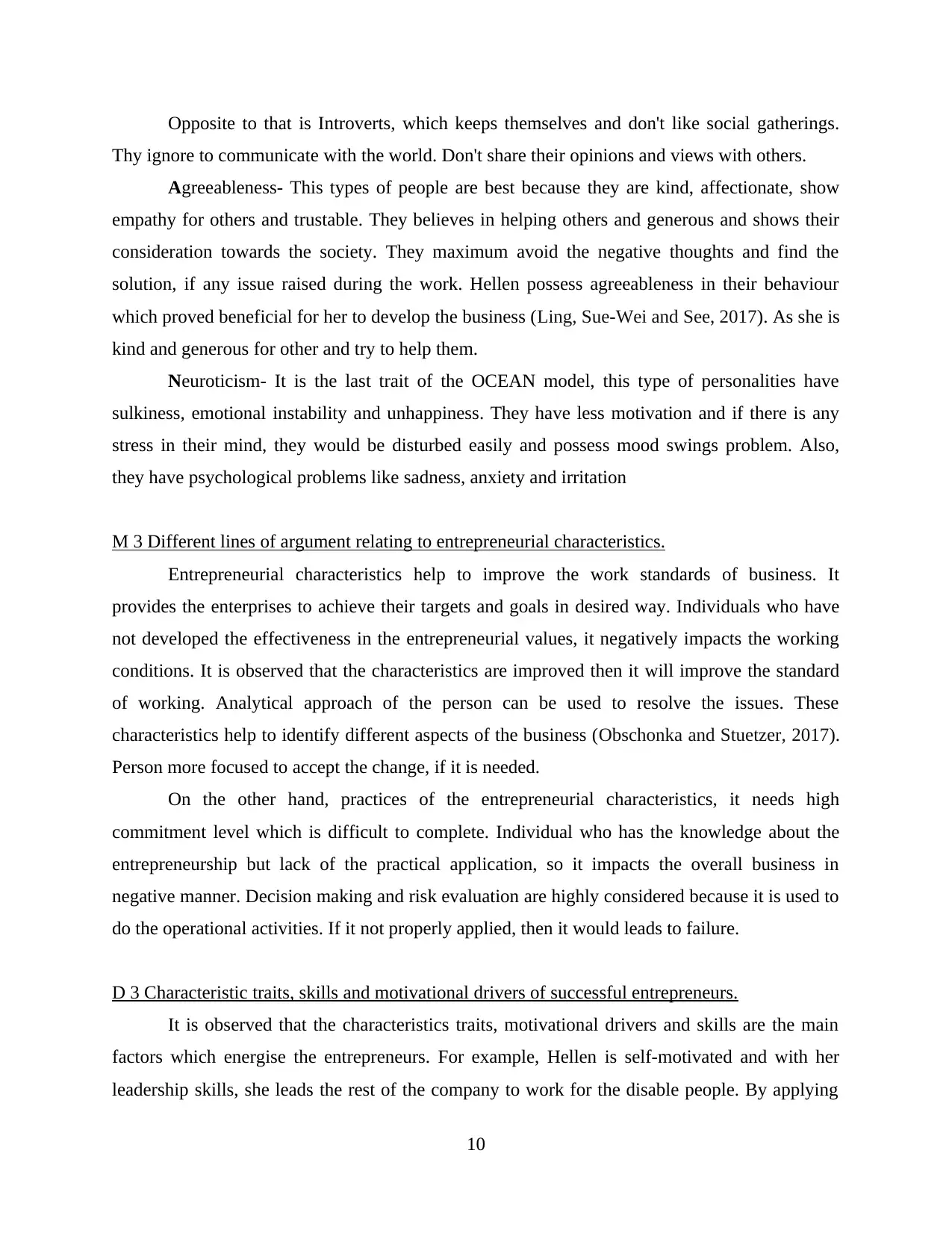
Opposite to that is Introverts, which keeps themselves and don't like social gatherings.
Thy ignore to communicate with the world. Don't share their opinions and views with others.
Agreeableness- This types of people are best because they are kind, affectionate, show
empathy for others and trustable. They believes in helping others and generous and shows their
consideration towards the society. They maximum avoid the negative thoughts and find the
solution, if any issue raised during the work. Hellen possess agreeableness in their behaviour
which proved beneficial for her to develop the business (Ling, Sue-Wei and See, 2017). As she is
kind and generous for other and try to help them.
Neuroticism- It is the last trait of the OCEAN model, this type of personalities have
sulkiness, emotional instability and unhappiness. They have less motivation and if there is any
stress in their mind, they would be disturbed easily and possess mood swings problem. Also,
they have psychological problems like sadness, anxiety and irritation
M 3 Different lines of argument relating to entrepreneurial characteristics.
Entrepreneurial characteristics help to improve the work standards of business. It
provides the enterprises to achieve their targets and goals in desired way. Individuals who have
not developed the effectiveness in the entrepreneurial values, it negatively impacts the working
conditions. It is observed that the characteristics are improved then it will improve the standard
of working. Analytical approach of the person can be used to resolve the issues. These
characteristics help to identify different aspects of the business (Obschonka and Stuetzer, 2017).
Person more focused to accept the change, if it is needed.
On the other hand, practices of the entrepreneurial characteristics, it needs high
commitment level which is difficult to complete. Individual who has the knowledge about the
entrepreneurship but lack of the practical application, so it impacts the overall business in
negative manner. Decision making and risk evaluation are highly considered because it is used to
do the operational activities. If it not properly applied, then it would leads to failure.
D 3 Characteristic traits, skills and motivational drivers of successful entrepreneurs.
It is observed that the characteristics traits, motivational drivers and skills are the main
factors which energise the entrepreneurs. For example, Hellen is self-motivated and with her
leadership skills, she leads the rest of the company to work for the disable people. By applying
10
Thy ignore to communicate with the world. Don't share their opinions and views with others.
Agreeableness- This types of people are best because they are kind, affectionate, show
empathy for others and trustable. They believes in helping others and generous and shows their
consideration towards the society. They maximum avoid the negative thoughts and find the
solution, if any issue raised during the work. Hellen possess agreeableness in their behaviour
which proved beneficial for her to develop the business (Ling, Sue-Wei and See, 2017). As she is
kind and generous for other and try to help them.
Neuroticism- It is the last trait of the OCEAN model, this type of personalities have
sulkiness, emotional instability and unhappiness. They have less motivation and if there is any
stress in their mind, they would be disturbed easily and possess mood swings problem. Also,
they have psychological problems like sadness, anxiety and irritation
M 3 Different lines of argument relating to entrepreneurial characteristics.
Entrepreneurial characteristics help to improve the work standards of business. It
provides the enterprises to achieve their targets and goals in desired way. Individuals who have
not developed the effectiveness in the entrepreneurial values, it negatively impacts the working
conditions. It is observed that the characteristics are improved then it will improve the standard
of working. Analytical approach of the person can be used to resolve the issues. These
characteristics help to identify different aspects of the business (Obschonka and Stuetzer, 2017).
Person more focused to accept the change, if it is needed.
On the other hand, practices of the entrepreneurial characteristics, it needs high
commitment level which is difficult to complete. Individual who has the knowledge about the
entrepreneurship but lack of the practical application, so it impacts the overall business in
negative manner. Decision making and risk evaluation are highly considered because it is used to
do the operational activities. If it not properly applied, then it would leads to failure.
D 3 Characteristic traits, skills and motivational drivers of successful entrepreneurs.
It is observed that the characteristics traits, motivational drivers and skills are the main
factors which energise the entrepreneurs. For example, Hellen is self-motivated and with her
leadership skills, she leads the rest of the company to work for the disable people. By applying
10
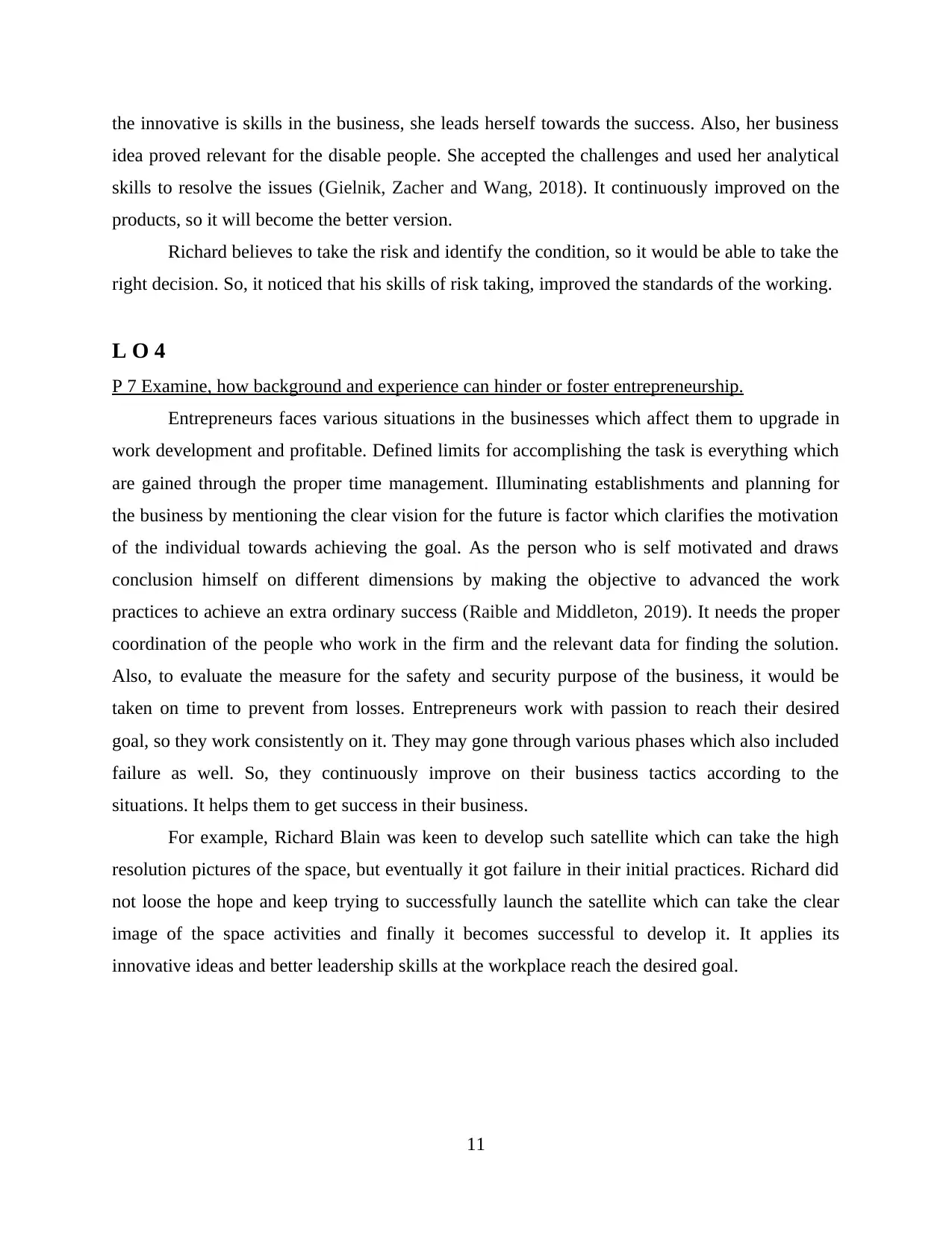
the innovative is skills in the business, she leads herself towards the success. Also, her business
idea proved relevant for the disable people. She accepted the challenges and used her analytical
skills to resolve the issues (Gielnik, Zacher and Wang, 2018). It continuously improved on the
products, so it will become the better version.
Richard believes to take the risk and identify the condition, so it would be able to take the
right decision. So, it noticed that his skills of risk taking, improved the standards of the working.
L O 4
P 7 Examine, how background and experience can hinder or foster entrepreneurship.
Entrepreneurs faces various situations in the businesses which affect them to upgrade in
work development and profitable. Defined limits for accomplishing the task is everything which
are gained through the proper time management. Illuminating establishments and planning for
the business by mentioning the clear vision for the future is factor which clarifies the motivation
of the individual towards achieving the goal. As the person who is self motivated and draws
conclusion himself on different dimensions by making the objective to advanced the work
practices to achieve an extra ordinary success (Raible and Middleton, 2019). It needs the proper
coordination of the people who work in the firm and the relevant data for finding the solution.
Also, to evaluate the measure for the safety and security purpose of the business, it would be
taken on time to prevent from losses. Entrepreneurs work with passion to reach their desired
goal, so they work consistently on it. They may gone through various phases which also included
failure as well. So, they continuously improve on their business tactics according to the
situations. It helps them to get success in their business.
For example, Richard Blain was keen to develop such satellite which can take the high
resolution pictures of the space, but eventually it got failure in their initial practices. Richard did
not loose the hope and keep trying to successfully launch the satellite which can take the clear
image of the space activities and finally it becomes successful to develop it. It applies its
innovative ideas and better leadership skills at the workplace reach the desired goal.
11
idea proved relevant for the disable people. She accepted the challenges and used her analytical
skills to resolve the issues (Gielnik, Zacher and Wang, 2018). It continuously improved on the
products, so it will become the better version.
Richard believes to take the risk and identify the condition, so it would be able to take the
right decision. So, it noticed that his skills of risk taking, improved the standards of the working.
L O 4
P 7 Examine, how background and experience can hinder or foster entrepreneurship.
Entrepreneurs faces various situations in the businesses which affect them to upgrade in
work development and profitable. Defined limits for accomplishing the task is everything which
are gained through the proper time management. Illuminating establishments and planning for
the business by mentioning the clear vision for the future is factor which clarifies the motivation
of the individual towards achieving the goal. As the person who is self motivated and draws
conclusion himself on different dimensions by making the objective to advanced the work
practices to achieve an extra ordinary success (Raible and Middleton, 2019). It needs the proper
coordination of the people who work in the firm and the relevant data for finding the solution.
Also, to evaluate the measure for the safety and security purpose of the business, it would be
taken on time to prevent from losses. Entrepreneurs work with passion to reach their desired
goal, so they work consistently on it. They may gone through various phases which also included
failure as well. So, they continuously improve on their business tactics according to the
situations. It helps them to get success in their business.
For example, Richard Blain was keen to develop such satellite which can take the high
resolution pictures of the space, but eventually it got failure in their initial practices. Richard did
not loose the hope and keep trying to successfully launch the satellite which can take the clear
image of the space activities and finally it becomes successful to develop it. It applies its
innovative ideas and better leadership skills at the workplace reach the desired goal.
11
Paraphrase This Document
Need a fresh take? Get an instant paraphrase of this document with our AI Paraphraser
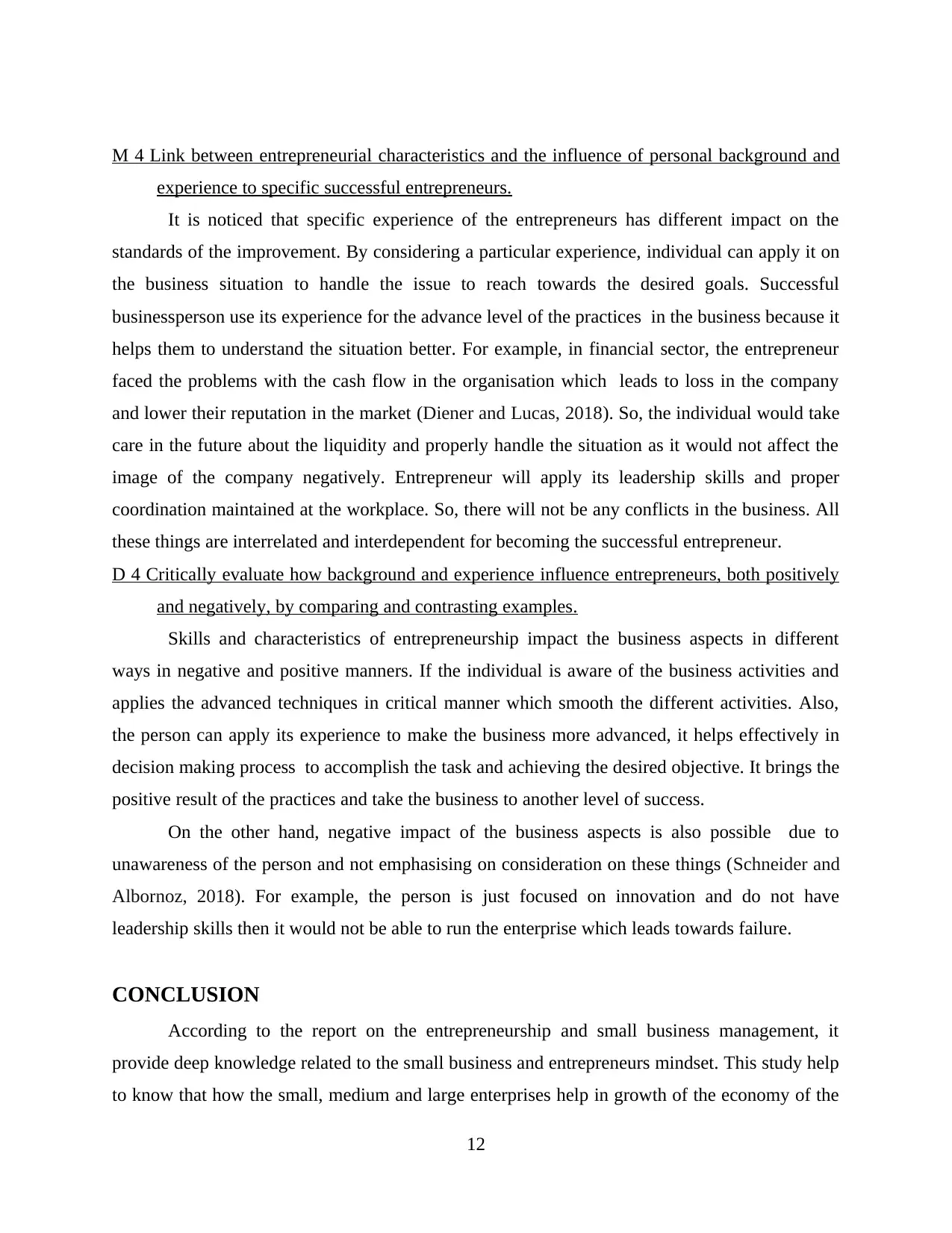
M 4 Link between entrepreneurial characteristics and the influence of personal background and
experience to specific successful entrepreneurs.
It is noticed that specific experience of the entrepreneurs has different impact on the
standards of the improvement. By considering a particular experience, individual can apply it on
the business situation to handle the issue to reach towards the desired goals. Successful
businessperson use its experience for the advance level of the practices in the business because it
helps them to understand the situation better. For example, in financial sector, the entrepreneur
faced the problems with the cash flow in the organisation which leads to loss in the company
and lower their reputation in the market (Diener and Lucas, 2018). So, the individual would take
care in the future about the liquidity and properly handle the situation as it would not affect the
image of the company negatively. Entrepreneur will apply its leadership skills and proper
coordination maintained at the workplace. So, there will not be any conflicts in the business. All
these things are interrelated and interdependent for becoming the successful entrepreneur.
D 4 Critically evaluate how background and experience influence entrepreneurs, both positively
and negatively, by comparing and contrasting examples.
Skills and characteristics of entrepreneurship impact the business aspects in different
ways in negative and positive manners. If the individual is aware of the business activities and
applies the advanced techniques in critical manner which smooth the different activities. Also,
the person can apply its experience to make the business more advanced, it helps effectively in
decision making process to accomplish the task and achieving the desired objective. It brings the
positive result of the practices and take the business to another level of success.
On the other hand, negative impact of the business aspects is also possible due to
unawareness of the person and not emphasising on consideration on these things (Schneider and
Albornoz, 2018). For example, the person is just focused on innovation and do not have
leadership skills then it would not be able to run the enterprise which leads towards failure.
CONCLUSION
According to the report on the entrepreneurship and small business management, it
provide deep knowledge related to the small business and entrepreneurs mindset. This study help
to know that how the small, medium and large enterprises help in growth of the economy of the
12
experience to specific successful entrepreneurs.
It is noticed that specific experience of the entrepreneurs has different impact on the
standards of the improvement. By considering a particular experience, individual can apply it on
the business situation to handle the issue to reach towards the desired goals. Successful
businessperson use its experience for the advance level of the practices in the business because it
helps them to understand the situation better. For example, in financial sector, the entrepreneur
faced the problems with the cash flow in the organisation which leads to loss in the company
and lower their reputation in the market (Diener and Lucas, 2018). So, the individual would take
care in the future about the liquidity and properly handle the situation as it would not affect the
image of the company negatively. Entrepreneur will apply its leadership skills and proper
coordination maintained at the workplace. So, there will not be any conflicts in the business. All
these things are interrelated and interdependent for becoming the successful entrepreneur.
D 4 Critically evaluate how background and experience influence entrepreneurs, both positively
and negatively, by comparing and contrasting examples.
Skills and characteristics of entrepreneurship impact the business aspects in different
ways in negative and positive manners. If the individual is aware of the business activities and
applies the advanced techniques in critical manner which smooth the different activities. Also,
the person can apply its experience to make the business more advanced, it helps effectively in
decision making process to accomplish the task and achieving the desired objective. It brings the
positive result of the practices and take the business to another level of success.
On the other hand, negative impact of the business aspects is also possible due to
unawareness of the person and not emphasising on consideration on these things (Schneider and
Albornoz, 2018). For example, the person is just focused on innovation and do not have
leadership skills then it would not be able to run the enterprise which leads towards failure.
CONCLUSION
According to the report on the entrepreneurship and small business management, it
provide deep knowledge related to the small business and entrepreneurs mindset. This study help
to know that how the small, medium and large enterprises help in growth of the economy of the
12

country and social economy. Successful entrepreneurs characteristics traits and skills are
evaluated which help them to achieve the success in their career. By applying the OCEAN model
of personality, it develops the insight knowledge about the entrepreneurial personalities. In last
the, discussion on how the experience and skills help to take hinder or foster the business. It
helps to know the essential aspects of the business which help the entrepreneurs to grab the
opportunities.
13
evaluated which help them to achieve the success in their career. By applying the OCEAN model
of personality, it develops the insight knowledge about the entrepreneurial personalities. In last
the, discussion on how the experience and skills help to take hinder or foster the business. It
helps to know the essential aspects of the business which help the entrepreneurs to grab the
opportunities.
13
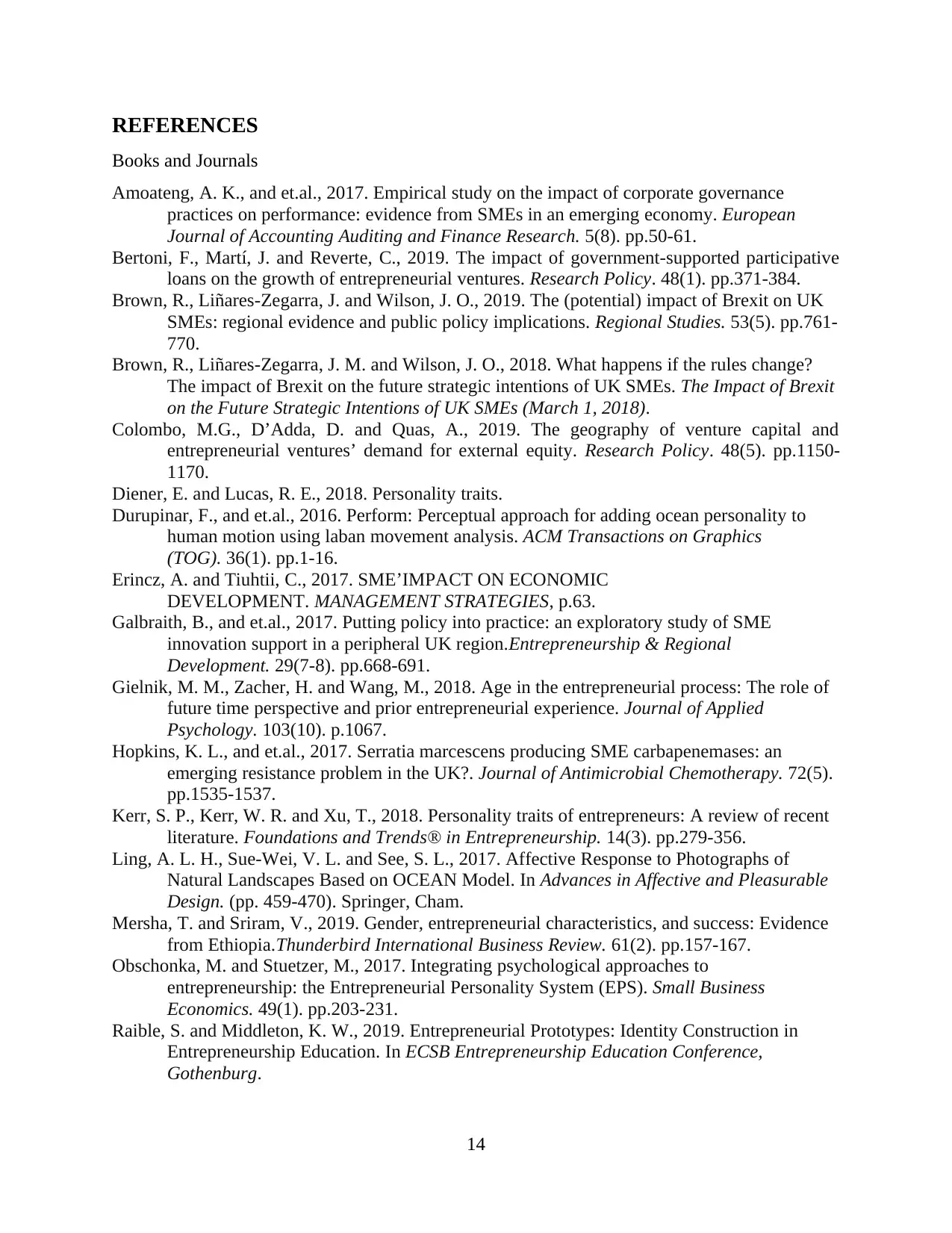
REFERENCES
Books and Journals
Amoateng, A. K., and et.al., 2017. Empirical study on the impact of corporate governance
practices on performance: evidence from SMEs in an emerging economy. European
Journal of Accounting Auditing and Finance Research. 5(8). pp.50-61.
Bertoni, F., Martí, J. and Reverte, C., 2019. The impact of government-supported participative
loans on the growth of entrepreneurial ventures. Research Policy. 48(1). pp.371-384.
Brown, R., Liñares-Zegarra, J. and Wilson, J. O., 2019. The (potential) impact of Brexit on UK
SMEs: regional evidence and public policy implications. Regional Studies. 53(5). pp.761-
770.
Brown, R., Liñares-Zegarra, J. M. and Wilson, J. O., 2018. What happens if the rules change?
The impact of Brexit on the future strategic intentions of UK SMEs. The Impact of Brexit
on the Future Strategic Intentions of UK SMEs (March 1, 2018).
Colombo, M.G., D’Adda, D. and Quas, A., 2019. The geography of venture capital and
entrepreneurial ventures’ demand for external equity. Research Policy. 48(5). pp.1150-
1170.
Diener, E. and Lucas, R. E., 2018. Personality traits.
Durupinar, F., and et.al., 2016. Perform: Perceptual approach for adding ocean personality to
human motion using laban movement analysis. ACM Transactions on Graphics
(TOG). 36(1). pp.1-16.
Erincz, A. and Tiuhtii, C., 2017. SME’IMPACT ON ECONOMIC
DEVELOPMENT. MANAGEMENT STRATEGIES, p.63.
Galbraith, B., and et.al., 2017. Putting policy into practice: an exploratory study of SME
innovation support in a peripheral UK region.Entrepreneurship & Regional
Development. 29(7-8). pp.668-691.
Gielnik, M. M., Zacher, H. and Wang, M., 2018. Age in the entrepreneurial process: The role of
future time perspective and prior entrepreneurial experience. Journal of Applied
Psychology. 103(10). p.1067.
Hopkins, K. L., and et.al., 2017. Serratia marcescens producing SME carbapenemases: an
emerging resistance problem in the UK?. Journal of Antimicrobial Chemotherapy. 72(5).
pp.1535-1537.
Kerr, S. P., Kerr, W. R. and Xu, T., 2018. Personality traits of entrepreneurs: A review of recent
literature. Foundations and Trends® in Entrepreneurship. 14(3). pp.279-356.
Ling, A. L. H., Sue-Wei, V. L. and See, S. L., 2017. Affective Response to Photographs of
Natural Landscapes Based on OCEAN Model. In Advances in Affective and Pleasurable
Design. (pp. 459-470). Springer, Cham.
Mersha, T. and Sriram, V., 2019. Gender, entrepreneurial characteristics, and success: Evidence
from Ethiopia.Thunderbird International Business Review. 61(2). pp.157-167.
Obschonka, M. and Stuetzer, M., 2017. Integrating psychological approaches to
entrepreneurship: the Entrepreneurial Personality System (EPS). Small Business
Economics. 49(1). pp.203-231.
Raible, S. and Middleton, K. W., 2019. Entrepreneurial Prototypes: Identity Construction in
Entrepreneurship Education. In ECSB Entrepreneurship Education Conference,
Gothenburg.
14
Books and Journals
Amoateng, A. K., and et.al., 2017. Empirical study on the impact of corporate governance
practices on performance: evidence from SMEs in an emerging economy. European
Journal of Accounting Auditing and Finance Research. 5(8). pp.50-61.
Bertoni, F., Martí, J. and Reverte, C., 2019. The impact of government-supported participative
loans on the growth of entrepreneurial ventures. Research Policy. 48(1). pp.371-384.
Brown, R., Liñares-Zegarra, J. and Wilson, J. O., 2019. The (potential) impact of Brexit on UK
SMEs: regional evidence and public policy implications. Regional Studies. 53(5). pp.761-
770.
Brown, R., Liñares-Zegarra, J. M. and Wilson, J. O., 2018. What happens if the rules change?
The impact of Brexit on the future strategic intentions of UK SMEs. The Impact of Brexit
on the Future Strategic Intentions of UK SMEs (March 1, 2018).
Colombo, M.G., D’Adda, D. and Quas, A., 2019. The geography of venture capital and
entrepreneurial ventures’ demand for external equity. Research Policy. 48(5). pp.1150-
1170.
Diener, E. and Lucas, R. E., 2018. Personality traits.
Durupinar, F., and et.al., 2016. Perform: Perceptual approach for adding ocean personality to
human motion using laban movement analysis. ACM Transactions on Graphics
(TOG). 36(1). pp.1-16.
Erincz, A. and Tiuhtii, C., 2017. SME’IMPACT ON ECONOMIC
DEVELOPMENT. MANAGEMENT STRATEGIES, p.63.
Galbraith, B., and et.al., 2017. Putting policy into practice: an exploratory study of SME
innovation support in a peripheral UK region.Entrepreneurship & Regional
Development. 29(7-8). pp.668-691.
Gielnik, M. M., Zacher, H. and Wang, M., 2018. Age in the entrepreneurial process: The role of
future time perspective and prior entrepreneurial experience. Journal of Applied
Psychology. 103(10). p.1067.
Hopkins, K. L., and et.al., 2017. Serratia marcescens producing SME carbapenemases: an
emerging resistance problem in the UK?. Journal of Antimicrobial Chemotherapy. 72(5).
pp.1535-1537.
Kerr, S. P., Kerr, W. R. and Xu, T., 2018. Personality traits of entrepreneurs: A review of recent
literature. Foundations and Trends® in Entrepreneurship. 14(3). pp.279-356.
Ling, A. L. H., Sue-Wei, V. L. and See, S. L., 2017. Affective Response to Photographs of
Natural Landscapes Based on OCEAN Model. In Advances in Affective and Pleasurable
Design. (pp. 459-470). Springer, Cham.
Mersha, T. and Sriram, V., 2019. Gender, entrepreneurial characteristics, and success: Evidence
from Ethiopia.Thunderbird International Business Review. 61(2). pp.157-167.
Obschonka, M. and Stuetzer, M., 2017. Integrating psychological approaches to
entrepreneurship: the Entrepreneurial Personality System (EPS). Small Business
Economics. 49(1). pp.203-231.
Raible, S. and Middleton, K. W., 2019. Entrepreneurial Prototypes: Identity Construction in
Entrepreneurship Education. In ECSB Entrepreneurship Education Conference,
Gothenburg.
14
Secure Best Marks with AI Grader
Need help grading? Try our AI Grader for instant feedback on your assignments.
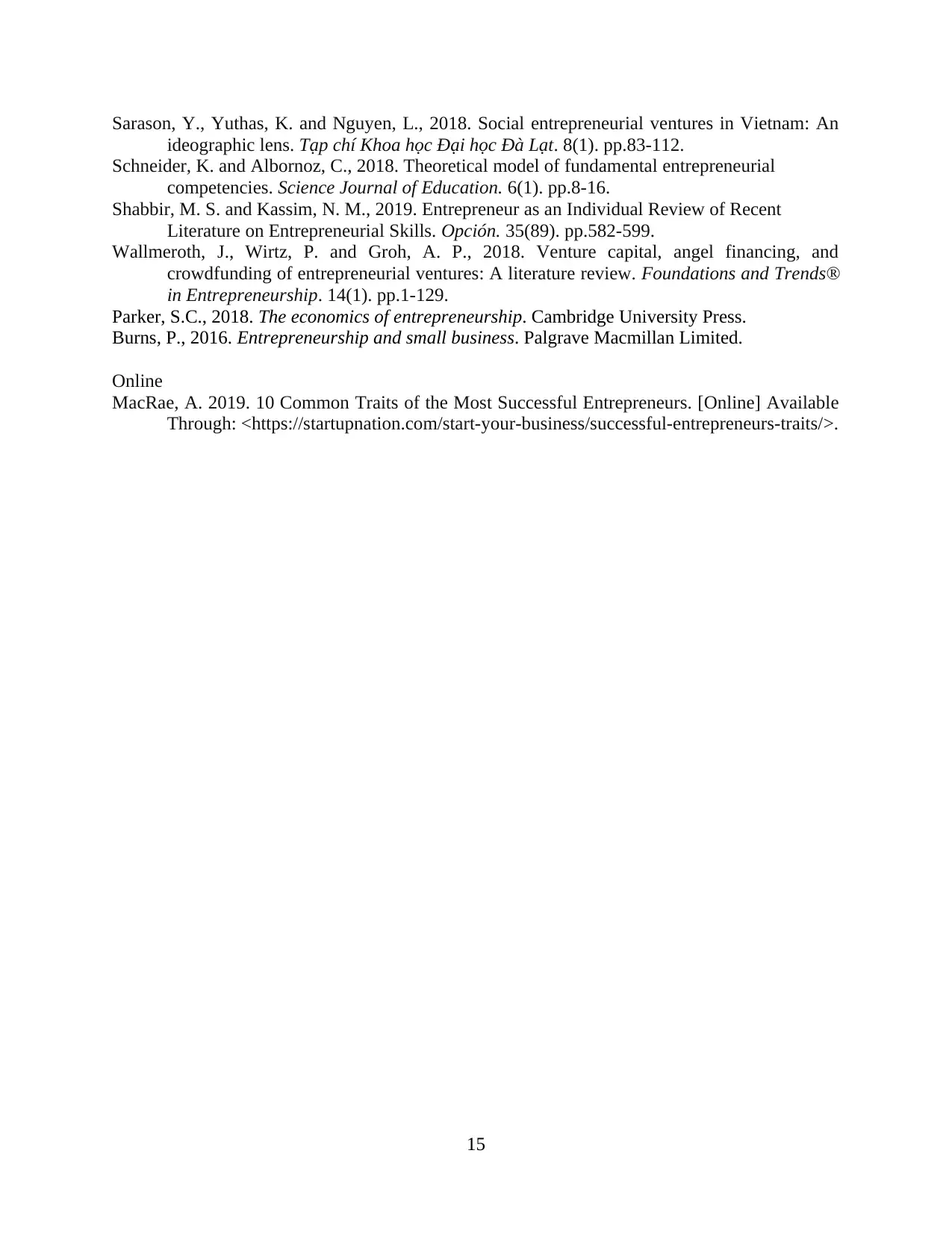
Sarason, Y., Yuthas, K. and Nguyen, L., 2018. Social entrepreneurial ventures in Vietnam: An
ideographic lens. Tạp chí Khoa học Đại học Đà Lạt. 8(1). pp.83-112.
Schneider, K. and Albornoz, C., 2018. Theoretical model of fundamental entrepreneurial
competencies. Science Journal of Education. 6(1). pp.8-16.
Shabbir, M. S. and Kassim, N. M., 2019. Entrepreneur as an Individual Review of Recent
Literature on Entrepreneurial Skills. Opción. 35(89). pp.582-599.
Wallmeroth, J., Wirtz, P. and Groh, A. P., 2018. Venture capital, angel financing, and
crowdfunding of entrepreneurial ventures: A literature review. Foundations and Trends®
in Entrepreneurship. 14(1). pp.1-129.
Parker, S.C., 2018. The economics of entrepreneurship. Cambridge University Press.
Burns, P., 2016. Entrepreneurship and small business. Palgrave Macmillan Limited.
Online
MacRae, A. 2019. 10 Common Traits of the Most Successful Entrepreneurs. [Online] Available
Through: <https://startupnation.com/start-your-business/successful-entrepreneurs-traits/>.
15
ideographic lens. Tạp chí Khoa học Đại học Đà Lạt. 8(1). pp.83-112.
Schneider, K. and Albornoz, C., 2018. Theoretical model of fundamental entrepreneurial
competencies. Science Journal of Education. 6(1). pp.8-16.
Shabbir, M. S. and Kassim, N. M., 2019. Entrepreneur as an Individual Review of Recent
Literature on Entrepreneurial Skills. Opción. 35(89). pp.582-599.
Wallmeroth, J., Wirtz, P. and Groh, A. P., 2018. Venture capital, angel financing, and
crowdfunding of entrepreneurial ventures: A literature review. Foundations and Trends®
in Entrepreneurship. 14(1). pp.1-129.
Parker, S.C., 2018. The economics of entrepreneurship. Cambridge University Press.
Burns, P., 2016. Entrepreneurship and small business. Palgrave Macmillan Limited.
Online
MacRae, A. 2019. 10 Common Traits of the Most Successful Entrepreneurs. [Online] Available
Through: <https://startupnation.com/start-your-business/successful-entrepreneurs-traits/>.
15
1 out of 17
Related Documents
Your All-in-One AI-Powered Toolkit for Academic Success.
+13062052269
info@desklib.com
Available 24*7 on WhatsApp / Email
![[object Object]](/_next/static/media/star-bottom.7253800d.svg)
Unlock your academic potential
© 2024 | Zucol Services PVT LTD | All rights reserved.





